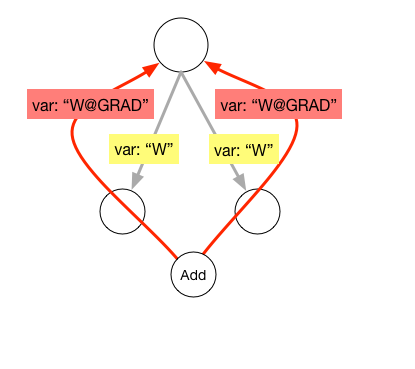# Operator/expression 's Backward
## Motivation
In Neural Network, the backpropagation algorithm follows the chain rule, so we need to compound the gradient operators/expressions together with the chain rule. Every forward network needs a backward network to construct the full computation graph, the operator/expression's backward pass will be generated respect to forward pass.
## Backward Operator Registry
A backward network is built up with several backward operators. Backward operators take forward operators' inputs outputs, and output gradients and then calculate its input gradients.
| | forward operator | backward operator
| ---------------------- | ---------------- |------------------------- |
| **Operator::inputs_** | Inputs | Inputs, Outputs, OutputGradients |
| **Operator::outputs_** | Outputs | InputGradients |
In most cases, there is a one-to-one correspondence between the forward and backward operators. These correspondences are recorded by a global hash map(`OpInfoMap`). To follow the philosophy of minimum core and make operators pluggable, the registry mechanism is introduced.
For example, we have got a `mul_op`, and we can register its information and corresponding backward operator by the following macro:
```cpp
REGISTER_OP(mul, MulOp, MulOpMaker, mul_grad, MulOpGrad);
```
`mul` is the operator's type. `MulOp` and `MulOpMaker` are the operator class and the operator maker class respectively.
`mul_grad` is the type of backward operator, and `MulOpGrad` is its class name.
## Backward Opeartor Creating
Given a certain forward operator, we can get its corresponding backward operator by calling:
```cpp
OperatorBase* bwd_op = BuildGradOp(const OperatorBase* fwd_op);
```
The function `BuildGradOp` will sequentially execute following processes:
1. Get the `type_` of given forward operator, and then get the corresponding backward operator's type by looking up the `OpInfoMap`.
2. Build two maps named `inputs` and `outputs` to temporary storage backward operator's inputs and outputs. Copy forward operator's `inputs_` and `outputs_` to map `inputs`, except these, are not necessary for gradient computing.
3. Add forward inputs' gradient variables into map `output`, adding forward outputs' gradient variables into map `input`.
4. Building backward operator with `inputs`, `outputs` and forward operator's attributes.
## Backward Network Building
A backward network is a series of backward operators. The main idea of building a backward network is creating backward operators in the inverted sequence and put them together.
In our design, the network itself is also a kind of operator. So the operators contained by a big network may be some small network.
given a forward network, it generates the backward network. We only care about the Gradients—`OutputGradients`, `InputGradients`.
1. Op
when the input forward network is an Op, return its gradient Operator Immediately.
2. NetOp
when the input forward network is a NetOp, it needs to call the sub NetOp/Operators backward function recursively. During the process, we need to collect the `OutputGradients` name according to the forward NetOp.
**shared variable**. As illustrated in the pictures, two operator's `Output` `Gradient` will overwrite their shared input variable.

1. Shared variable in operators.
Share variable between operators or same input variable used in multiple operators leads to a duplicate gradient variable. As demo show above, we need to rename gradient name recursively and add a generic add operator replace the overwrite links.

2. Replace shared variable's gradient with `Add` operator.
Then collect the sub graph `OutputGradients`/`InputGradients` as the NetOp's and return it.


